Solution Manual for Engineering Mechanics
Statics in SI Units 14th
Edition by Hibbeler
ISBN 1292089237
9781292089232
Full download link at: https://testbankpack.com/p/solutionmanual-for-engineering-mechanicsstatics-in-si-units-14th-edition-byhibbeler-isbn-12920892379781292089232/
Determine the magnitude of the resultant force

= F1 + F2 and its direction, measured clockwise from
positive u axis
Solution
Parallelogram Law.The parallelogram law of addition is shown in Fig. a, Trigonometry. Applying Law of cosines by referring to Fig. b,

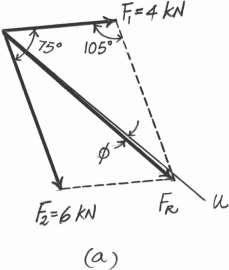
Using this result to apply Law of sines, Fig b,
Thus, the direction f of FR measured clockwise from the positive u axis is
© Pearson Education Limited 2017.All rights reserved.This material is protected under all copyright laws as they currently exist No portion of this material may be reproduced, in any form or by any means, without permission in writing from the publisher 22
2–1.
FR
the
v 30 75 F1 4 kN 30 u F2 6 kN
FR = 242 + 62 - 2(4)(6) cos 105 = 8.026 kN = 8.03 kN Ans.
sin u 6 = sin 105 ; u = 46.22 8.026
f =
Ans.
46.22 - 45 = 1.22
Ans: f = 1.22
© Pearson Education Limited 2017.All rights reserved.This material is protected under all copyright laws as they currently exist No portion of this material may be reproduced, in any form or by any means, without permission in writing from the publisher 23
Resolve the force F1 into components acting along the u and v axes and determinethe magnitudesof the components
Solution
Parallelogram Law.The parallelogram law of addition is shown in Fig a, Trigonometry. Applying the sines law by referring to Fig b
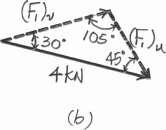

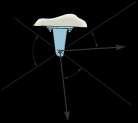
© Pearson Education Limited 2017.All rights reserved.This material is protected under all copyright laws as they currently exist No portion of this material may be reproduced, in any form or by any means, without permission in writing from the publisher 24 2–2.
v 30 75 F1 4 kN 30 u F2 6 kN
(F1)v 4 sin 45 = sin 105 ; (F1)v = 2.928 kN = 2.93 kN Ans. (F1)u 4 sin 30 = sin 105 ; (F1)u = 2.071 kN = 2.07 kN Ans. Ans: (F1)v = 2.93 kN (F1)u = 2.07 kN
Resolve the force F2 into components acting along the u and v axes and determinethe magnitudesof the components
Solution
Parallelogram Law The parallelogram law of addition is shown in Fig a, Trigonometry. Applying the sines law of referring to Fig. b,
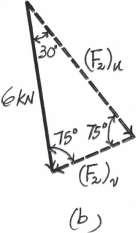
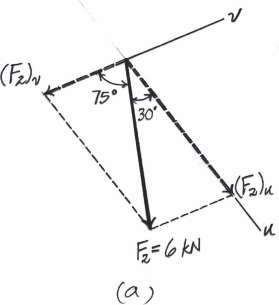
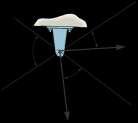
© Pearson Education Limited 2017.All rights reserved.This material is protected under all copyright laws as they currently exist No portion of this material may be reproduced, in any form or by any means, without permission in writing from the publisher 25 2–3.
v 30 75 F1 4 kN 30 u F2 6 kN
(F2)u 6 sin 75 = sin 75 ; (F2)u = 6.00 kN Ans. (F2)v 6 sin 30 = sin 75 ; (F2)v = 3.106 kN = 3.11 kN Ans. Ans: (F2)u = 6.00 kN (F2)v = 3.11 kN
*2–4.
If 60° and 450 N, determine the magnitude of the resultant force and its direction,measured counterclockwise
from the positive x axis
SOLUTION
The parallelogram law of addition and the triangular rule are shown in Figs a and b, respectively
Applying
law
Thus, the direction of angle of F positive axis, is

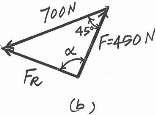

© Pearson Education Limited 2017.All rights reserved.This material is protected under all copyright laws as they currently exist No portion of this material may be reproduced, in any form or by any means, without permission in writing from the publisher 26
y
F
b, 7002 4502 2(700)(450) cos 45° x 15 700 N 497.01 N 497 N Ans. This yields sin 700 sin 45° 497.01 95.19°
the
of consines to Fig
measured
60° 95.19° 60° 155° Ans. Ans: FR = 497 N
counterclockwise from the
© Pearson Education Limited 2017.All rights reserved.This material is protected under all copyright laws as they currently exist No portion of this material may be reproduced, in any form or by any means, without permission in writing from the publisher 27 f = 155
5.
If the magnitude of the resultant force is to be 500 N, y directed along the positive y axis, determine the magnitude F of force F and its direction u

u x 15
700 N
SOLUTION
The parallelogram law of addition and the triangular rule are shown in Figs a and b, respectively.
Applying the law of cosines to Fig b,
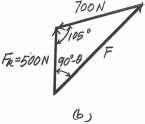
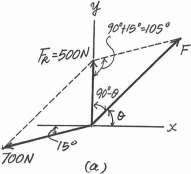
F = 25002 + 7002 - 2(500)(700) cos 105°
= 959.78 N = 960 N
Applying the law of sines to Fig b, and using this result, yields
sin (90° + u) 700 = sin 105° 959.78
Ans.
u = 45.2° Ans.
Ans:
© Pearson Education Limited 2017.All rights reserved.This material is protected under all copyright laws as they currently exist No portion of this material may be reproduced, in any form or by any means, without permission in writing from the publisher 28
2–
© Pearson Education Limited 2017.All rights reserved.This material is protected under all copyright laws as they currently exist No portion of this material may be reproduced, in any form or by any means, without permission in writing from the publisher 29 F = 960 N u = 45.2
2–6. If FB = 2 kN and the resultant force acts along the y positive u axis, determine the magnitude of the resultant force and the angle u

Solution
The parallelogram law of addition and the triangular rule are shown in Figs. a and b, respectively
Applying the law of sines to Fig b, yields
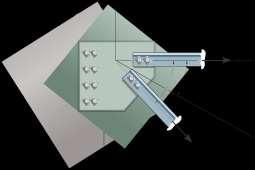
Thus,
With the result u = 78.59 , applying the law of sines to Fig b again, yields
© Pearson Education Limited 2017.All rights reserved.This material is protected under all copyright laws as they currently exist No portion of this material may be reproduced, in any form or by any means, without permission in writing from the publisher 30
u 30 B FB FA 3 kN x A u
sin f 3
sin
f = 48.59 3
=
30
u
78.6 Ans.
= 30 + f = 30 + 48.59 = 78.59 =
FR sin(180 - 78.59 ) = 2 FR = 3.92 kN Ans. sin 30 Ans: 78.6° FR = 3.92 kN
2–7. If the resultant force is required to act along the y
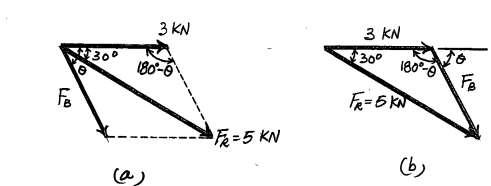

positive u axis and have a magnitude of 5 kN, determine the required magnitude of FB and its direction u
Solution
The parallelogram law of addition and the triangular rule are shown in Figs a and b, respectively
Applying the law of cosines to Fig b,
FB = 232 + 52 - 2(3)(5) cos 30 = 2.832kN = 2.83 kN Ans.
Using this result and realizing that sin(180 - u) = sin u, the application of the sine law to Fig b, yields sin u
© Pearson Education Limited 2017.All rights reserved.This material is protected under all copyright laws as they currently exist No portion of this material may be reproduced, in any form or by any means, without permission in writing from the publisher 31
u 30 B FB FA 3 kN x A u
5
Ans. 2.832 Ans: 2.83 kN u = 62 0
= sin 30 u = 62.0
*2–8. Determine the magnitude of the resultant force
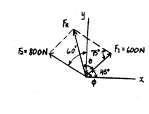
FR = F1 + F2 and its direction, measured clockwise from the positive x axis

© Pearson Education Limited 2017.All rights reserved.This material is protected under all copyright laws as they currently exist No portion of this material may be reproduced, in any form or by any means, without permission in writing from the publisher 32
F2 800 N y F1 = 600 N 60° F3 = 450 N 75° 45° x Solution
R = 2(600)2 + (800)2 - 2(600)(800)cos 75 = 866.91 = 867 N Ans. 866.91 800 sin 75 = sin u u = 63.05 f = 63.05 + 45 = 108 Ans. Ans: u = 108
F
Resolve F1 into components along the u and v axes and determine the magnitudes of these components



© Pearson Education Limited 2017.All rights reserved.This material is protected under all copyright laws as they currently exist No portion of this material may be reproduced, in any form or by any means, without permission in writing from the publisher 33
2–9.
v F1 250 N SOLUTION Sine law: F2 150 N 30 30 u 105 F1v sin 30° = F1u sin 45° = 250 sin 105° 250 sin 105° F1v = 129 N F1u = 183 N Ans Ans. Ans: F1v = 129 N F1u = 183 N
2–10.
Resolve F2 into components along the u and v axes and determine the magnitudes of these components

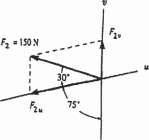

© Pearson Education Limited 2017.All rights reserved.This material is protected under all copyright laws as they currently exist No portion of this material may be reproduced, in any form or by any means, without permission in writing from the publisher 34
v F1 250 N SOLUTION Sine law: F2v sin 30° = F2u sin 75° = 150 sin 75° 150 sin 75° F2v = 77.6 N F2u = 150 N Ans. Ans. F2 150 N 30 30 u 105 Ans: F2v = 77 6 N F2u = 150 N
2–11. The device is used for surgical replacement of the knee joint. If the force acting along the leg is 360 N, determine its components along the x and y¿ axes.
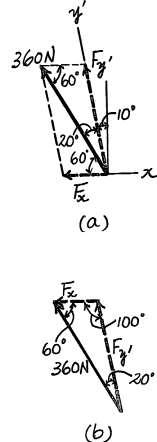

© Pearson Education Limited 2017.All rights reserved.This material is protected under all copyright laws as they currently exist No portion of this material may be reproduced, in any form or by any means, without permission in writing from the publisher 35 x¿ x
y¿ y 10 x¿ x Solution 60 360 N -Fx sin 20 = Fy sin 60 = 360 ; Fx = -125 N Ans. sin 100 360 ; Fy = 317 N Ans. sin 100 Ans: Fx = -125 N Fy = 317 N
*2–12. The device is used for surgical replacement of the knee joint. If the force acting along the leg is 360 N, determine its components along the x¿ and y axes.
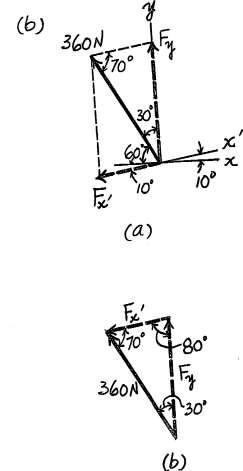
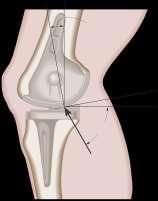
© Pearson Education Limited 2017.All rights reserved.This material is protected under all copyright laws as they currently exist No portion of this material may be reproduced, in any form or by any means, without permission in writing from the publisher 36
y¿ y 10 x¿ x Solution 60 360 N -Fx sin 30 = Fy sin 70 = 360 ; Fx = -183 N Ans. sin 80 360 ; Fy = 344 N Ans. sin 80 Ans: Fx = - 183 N Fy = 344 N
2-13.
If the tension in the cable is 400 N, determine the magnitude and direction of the resultant force acting on the pulley. This angle defines the same angle of line AB on the tailboard block.

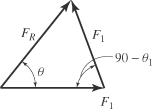
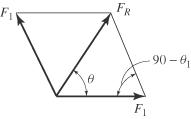
© Pearson Education Limited 2017.All rights reserved.This material is protected under all copyright laws as they currently exist No portion of this material may be reproduced, in any form or by any means, without permission in writing from the publisher 37
400 N y 30 u x B 400 N A Solution FR F1 2 F1 2 2F1 F1 cos 90 1 1 30 FR 400 N sin 90 FR FR sin 1 F1 90 asin F1 sin 1 60 Ans. Ans: u = 60
2
14. The truck is to be towed using two ropes Determine y the magnitude of forces FA and FB acting on each rope in order to develop a resultant force of 950 N directed along the positive x axis. Set u = 50°.
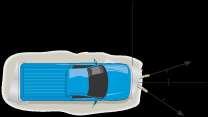
Solution
Parallelogram Law: The parallelogram law of addition is shown in Fig (a).
Trigonometry: Using law of sines [Fig. (b)], we have
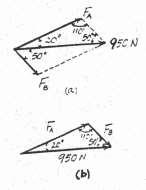
FA 950
sin 50 = sin 110
FA = 774 N
FB 950
sin 20 = sin 110
FB = 346 N
Ans.
Ans.
© Pearson Education Limited 2017.All rights reserved.This material is protected under all copyright laws as they currently exist No portion of this material may be reproduced, in any form or by any means, without permission in writing from the publisher 38
–
FA A 20° x B θ FB
A
N
B
346 N
Ans: F
= 774
F
=
The plate is subjected to the two forces at A and B as shown. If u = 60°,determine the magnitude of the resultant of these two forces and its direction measured clockwise from the horizontal.


SOLUTION
Parallelogram Law: The parallelogram law of addition is shown in Fig a
Trigonometry: Using law of cosines (Fig b), we have

FR = 282 + 62 - 2(8)(6) cos 100° = 10.80 kN = 10.8 kN
The angle u can be determined using law of sines (Fig b).
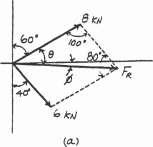
sin u
6 = sin 100° 10.80
sin u = 0.5470 u = 33.16°
Thus, the direction f of FR measured from the x axis is





f = 33.16° - 30° = 3.16° Ans.
Ans:
FR = 10.8 kN
f = 3.16
© Pearson Education Limited 2017.All rights reserved.This material is protected under all copyright laws as they currently exist No portion of this material may be reproduced, in any form or by any means, without permission in writing from the publisher 39 2–15.
FA 8 kN u A
40 B FB 6 kN
Ans.
*2–16.
Determine the angle of u for connectingmember A to the plate so that the resultant force of FA and FB is directed horizontally to the right Also, what is the magnitude of the resultant force?

SOLUTION
Parallelogram Law: The parallelogram law of addition is shown in Fig. a.
Trigonometry: Using law of sines (Fig .b), we have
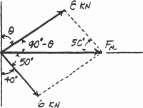


sin (90° - u) 6 = sin 50° 8
sin (90° - u) = 0.5745
u = 54.93° = 54.9°
From the triangle, f = 180° - (90° - 54.93°) - 50° = 94.93° Thus, using law of cosines, the magnitude of FR is





- 2(8)(6) cos 94.93°
= 10.4 kN
= 54.9
© Pearson Education Limited 2017.All rights reserved.This material is protected under all copyright laws as they currently exist No portion of this material may be reproduced, in any form or by any means, without permission in writing from the publisher 40
FA 8 kN u A 40 B FB 6 kN
Ans.
2
2
FR = 28
+ 6
Ans.
F
Ans: u
R = 10.4 kN
2–17.
Two forces act on the screw eye. If F1 = 400 N and
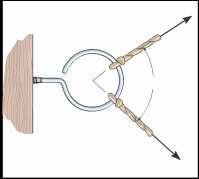
F2 = 600 N, determine the angle u(0° … u … 180°)
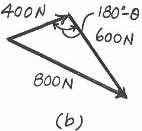
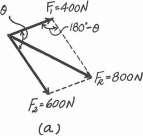
between them, so that the resultant force has a magnitude of FR = 800 N
SOLUTION
The parallelogram law of addition and triangular rule are shown in Figs a and b, respectively Applying law of cosines to Fig b,
800 = 24002 + 6002 - 2(400)(600) cos (180° - u°)
8002 = 4002 + 6002 - 480000 cos (180° - u)
cos (180° - u) = - 0.25
180° - u = 104.48
u = 75.52° = 75.5°
Ans.
© Pearson Education Limited 2017.All rights reserved.This material is protected under all copyright laws as they currently exist No portion of this material may be reproduced, in any form or by any means, without permission in writing from the publisher 41
F1
F2
u
Ans: u = 75.5
Two forces F1 and F2 act on the screw eye. If their lines of F1 action are at an angle u apart and the magnitude of each force is F1 = F2 = F, determine the magnitude of the

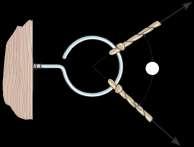
resultant force FR and the angle between FR and F1

SOLUTION
F F sin f = sin (u - f)
sin (u - f) = sin f
u - f = f u
f = 2
FR = 2(F)2 + (F)2 - 2(F)(F) cos (180° - u)
Since cos (180° - u) = - cos u
FR = FA 22B21 + cos u
Ans.
u Since cos a
b = A 1 + cos u
© Pearson Education Limited 2017.All rights reserved.This material is protected under all copyright laws as they currently exist No portion of this material may be reproduced, in any form or by any means, without permission in writing from the publisher 42
2–18.
u
F2
2 Then u FR = 2F cosa 2 b Ans. Ans: u f = 2 u FR = 2F cos a 2 b
2
Determine the magnitude and direction of the resultant force, FR measured counterclockwise from the positive x axis Solve the problem by first finding the resultant F = F1 + F2 and then forming FR = F + F3
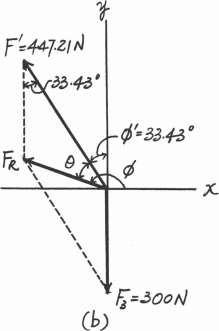
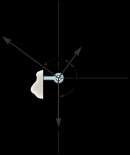
Solution
Parallelogram Law. The parallelogram law of addition for F1 and F2 and then their resultant F and F3 are shown in Figs a and b, respectively Trigonometry. Referring to Fig c,

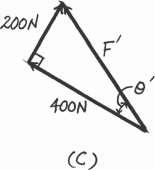
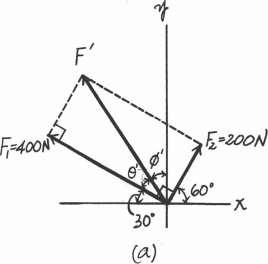
F = 22002 + 4002 = 447.21 N u = tan-1
Thus f = 90 - 30 - 26.57 = 33.43
Using these results to apply the law of cosines by referring to Fig. d,
FR = 23002 + 447.212 - 2(300)(447.21) cos 33.43 =
Then, apply the law of sines, sin u 300 = sin 33.43 ; u = 40.02 257.05
Thus, the direction f of FR measured counterclockwisefrom the positive x axis is
f = 90 + 33.43 + 40.02 = 163.45 = 163 Ans.
© Pearson Education Limited 2017.All rights reserved.This material is protected under all copyright laws as they currently exist No portion of this material may be reproduced, in any form or by any means, without permission in writing from the publisher 43 2–19.
F1 400 N y 90º F2 200 N x 150º F3 300 N
a
200 400 b = 26.57
257.05 N = 257 kN Ans.
Ans: FR
N
= 257
f = 163
*2–20. Determine the magnitude and direction of the resultant force, FR measured counterclockwise from the positive x axis Solve the problem by first finding the resultant F = F2 + F3 and then forming FR = F + F1
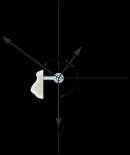

Solution
Parallelogram Law The parallelogram law of addition for F2 and F3 and then their resultant F and F1 are shown in Figs a and b, respectively Trigonometry. Applying the law of cosines by referring to Fig c,

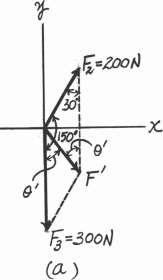

F = 22002 + 3002 - 2(200)(300) cos 30 = 161.48 N Ans.
Using this result to apply the sines law, Fig c, sin u sin 30
200 = 161.48 ; u = 38.26
Using the results of F and u to apply the law of cosines by referring to Fig d,
FR = 2161.482 + 4002 - 2(161.48)(400) cos 21.74 = 257.05 N = 257 N Ans.
Then, apply the sines law, sin u 161.48 = sin 21.74 ; u = 13.45 257.05
Thus, the direction f of FR measured counterclockwisefrom the positive x axis is
f = 90 + 60 + 13.45 = 163.45 = 163 Ans.
© Pearson Education Limited 2017.All rights reserved.This material is protected under all copyright laws as they currently exist No portion of this material may be reproduced, in any form or by any means, without permission in writing from the publisher 44
F1 400 N y 90º F2 200 N x 150º F3 300 N
Ans: f = 163 FR = 257 N
2–21. The log is being towed by two tractors A and B y Determine the magnitude of the two towing forces FA and FB if it is required that the resultant force have a magnitude FR = 10 kN and be directed along the x axis Set u = 15°.


Solution
Parallelogram Law: The parallelogram law of addition is shown in Fig (a).

Trigonometry: Using law of sines [Fig (b)], we have
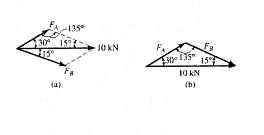

FA sin 15 = 10 sin 135
FA = 3.66 kN
FB sin 30 = 10 sin 135
Ans.
FB = 7.07 kN Ans.
© Pearson Education Limited 2017.All rights reserved.This material is protected under all copyright laws as they currently exist No portion of this material may be reproduced, in any form or by any means, without permission in writing from the publisher 45
FA 30° A x θ FB B
Ans: FA = 3 66 kN FB = 7 07 kN
2
22. If the resultant FR of the two forces acting on the log is to be directed along the positive x axis and have a magnitude of 10 kN, determine the angle u of the cable, attached to B such that the force FB in this cable is minimum. What is the magnitude of the force in each cable for this situation?
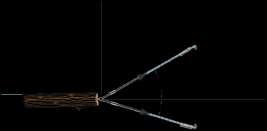
Solution
Parallelogram Law: In order to produce a minimum force, FB, FB has to act perpendicular to FA The parallelogram law of addition is shown in Fig (a).
Trigonometry: Fig.(b).
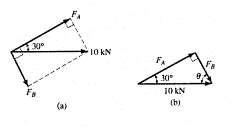
FB = 10 sin 30 = 5.00 kN
FA = 10 cos 30 = 8.66 kN

The angle u is


u = 90 - 30 = 60.0
Ans.
Ans.
Ans.
© Pearson Education Limited 2017.All rights reserved.This material is protected under all copyright laws as they currently exist No portion of this material may be reproduced, in any form or by any means, without permission in writing from the publisher 46
–
y FA 30° A x θ FB B
Ans: FB = 5 00 kN FA = 8 66 kN u = 60 0
Determine the magnitude and direction of the resultant F

=
1 + F2 + F3 of the three forces by first finding the resultant
and then forming

© Pearson Education Limited 2017.All rights reserved.This material is protected under all copyright laws as they currently exist No portion of this material may be reproduced, in any form or by any means, without permission in writing from the publisher 47
2–23.
¿
F1
F2
R = F¿
F3
y F1 30 N 5 3 4 F3 50 N x 20 F¿ = 2(20)2 + (30)2 - 2(20)(30) cos 73.13° = 30.85 N F2 20 N 30.85 30 ¿ sin 73.13° = sin (70° - u¿) ; u = 1.47° FR = 2(30.85)2 + (50)2 - 2(30.85)(50) cos 1.47° = 19.18 = 19.2 N Ans. 19.18 sin 1.47° 30.85 = sin u ; u = 2.37° Ans. Ans: FR = 19.2 N u = 2.37 c
R
F
F
=
+
F
+
.
*2–24.
Determine the magnitude and direction of the resultant F


of the three forces by first finding the
then forming
© Pearson Education Limited 2017.All rights reserved.This material is protected under all copyright laws as they currently exist No portion of this material may be reproduced, in any form or by any means, without permission in writing from the publisher 48
F1
y F1 30 N 5 3 4 F3 50 N x 20 F ¿ = 2(20)2 + (50)2 - 2(20)(50) cos 70° = 47.07 N F2 20 N 20 sin u¿ 47.07 = sin 70°; u¿ = 23.53° FR = 2(47.07)2 + (30)2 - 2(47.07)(30) cos 13.34° = 19.18 = 19.2 N Ans. 19.18 30 sin 13.34° = sin f; f = 21.15° u = 23.53° - 21.15° = 2.37° Ans Ans: FR = 19.2 N u = 2.37 c
R = F1 + F2 + F3
resultant F¿ = F2 + F3 and
FR = F¿ +
.
2–25.
If the resultant force of the two tugboats is 3 kN, directed along the positive x axis, determine the required magnitude of force FB and its direction u.
SOLUTION
The parallelogram law of addition and the triangular rule are shown in Figs a and b, respectively
Applying the law of cosines to Fig. b,
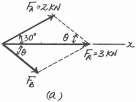
FB = 222 + 32 - 2(2)(3)cos 30°
= 1.615kN = 1.61 kN



Using this result and applying the law of sines to Fig b, yields

sin u 2 sin 30° = 1.615 u = 38.3°
Ans.
Ans.
© Pearson Education Limited 2017.All rights reserved.This material is protected under all copyright laws as they currently exist No portion of this material may be reproduced, in any form or by any means, without permission in writing from the publisher 49 C
y A FA 2 kN 30 x u
FB
B
B
Ans: F
= 1.61 kN u = 38.3
2–26.
If FB = 3 kN and u = 45°, determine the magnitude of the resultant force of the two tugboats and its direction measured clockwise from the positive x axis
SOLUTION
The parallelogram law of addition and the triangular rule are shown in Figs. a and b, respectively
Applying the law of cosines to Fig. b,
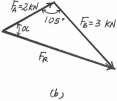
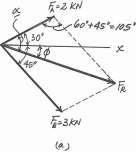
FR = 222 + 32 - 2(2)(3) cos 105°
= 4.013 kN = 4.01 kN Ans.
Using this result and applying the law of sines to Fig b, yields sin a sin 105° 3 = 4.013 a = 46.22°

Thus, the direction angle f of FR, measured clockwise from the positive x axis, is f = a - 30° = 46.22° - 30° = 16.2° Ans.


= 16.2
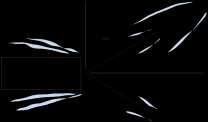
© Pearson Education Limited 2017.All rights reserved.This material is protected under all copyright laws as they currently exist No portion of this material may be reproduced, in any form or by any means, without permission in writing from the publisher 50
y A FA 2 kN 30 x u C FB B
Ans: FR
kN f
= 4.01
If the resultant force of the two tugboats is required to be directed towards the positive x axis, and FB is to be a minimum, determine the magnitude of FR and FB and the angle u
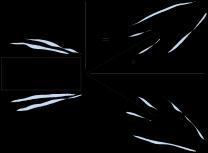
SOLUTION
For FB to be minimum, it has to be directed perpendicular to FR Thus,


90°
The parallelogram law of addition and triangular rule are shown in Figs a and b, respectively
By applying simple trigonometry to Fig b,

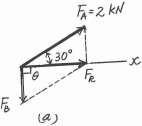
FB = 2 sin 30° = 1 kN
FR = 2 cos 30° = 1.73 kN
© Pearson Education Limited 2017.All rights reserved.This material is protected under all copyright laws as they currently exist No portion of this material may be reproduced, in any form or by any means, without permission in writing from the publisher 51 2–27.
y A FA 2 kN
u
30 x u C FB Ans. B
=
Ans. Ans. Ans: u = 90 FB = 1 kN FR = 1.73 kN
–28.
Determine the magnitude of force F so that the resultant FR of the three forces is as small as possible. What is the minimum magnitude of FR?
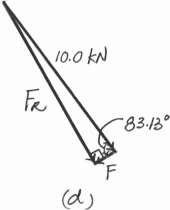

Solution
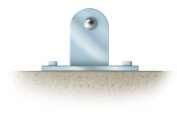
Parallelogram Law. The parallelogram laws of addition for 6 kN and 8 kN and then their resultant F and F are shown in Figs. a and b, respectively. In order for FR to be minimum, it must act perpendicular to F

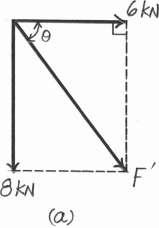
© Pearson Education Limited 2017.All rights reserved.This material is protected under all copyright laws as they currently exist No portion of this material may be reproduced, in any form or by any means, without permission in writing from the publisher 52 a
*2
8 kN F 30 6 kN
Trigonometry. Referring to Fig. b, 8 F = 262 + 82 = 10.0 kN u = tan - 1 6 Referring to Figs c and d, b = 53.13 FR = 10.0 sin 83.13 = 9.928 kN = 9.93 kN Ans. F = 10.0 cos 83.13 = 1.196 kN = 1.20 kN Ans. Ans: FR = 9.93 kN F = 1.20 kN
Determine the magnitude and direction u of FA so that the
resultant force is directed along the positive x axis and has a magnitude of
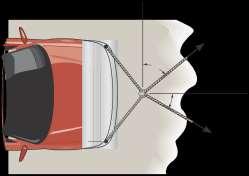
© Pearson Education Limited 2017.All rights reserved.This material is protected under all copyright laws as they currently exist No portion of this material may be reproduced, in any form or by any means, without permission in writing from the publisher 53 2–29.
y
N. FA A θ x O 30° SOLUTION S + FRx = ΣFx; FRx = FA sin u + 800 cos 30° = 1250 + c FRy = ΣFy; FRy = FA cos u - 800 sin 30° = 0 u = 54.3° Ans. FA = 686 N Ans. B FB = 800 N Ans: u = 54.3 FA = 686 N
1250
–30.
Determine the magnitude and direction, measured y counterclockwise from the positive x axis, of the resultant force acting on the ring at O, if FA = 750 N and u = 45°
SOLUTION
Scalar Notation: Suming the force components algebraically, we have S + FRx = ΣFx; FRx = 750 sin 45° + 800 cos 30°
= 1223.15 N S
+ c FRy = ΣFy; FRy = 750 cos 45° - 800 sin 30°
= 130.33 N c
The magnitude of the resultant force FR is
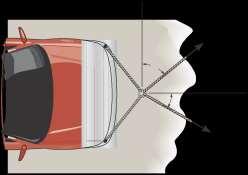
21223.152 + 130.332 = 1230 N = 1.23 kN
The directional angle u measured counterclockwisefrom positive x axis is

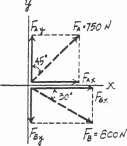
= 1.23 kN
= 6.08
© Pearson Education Limited 2017.All rights reserved.This material is protected under all copyright laws as they currently exist No portion of this material may be reproduced, in any form or by any means, without permission in writing from the publisher 54
2
FA A θ x O 30°
B FB = 800 N 2 2 FR = 3F Rx + F Ry =
Ans.
FRy u = tan-1 = tan-1 a FRx 130.33 1223.15 b = 6.08° Ans. Ans: FR
u
2–31.
Two forces act on the screw eye. If F = 600 N, determine the magnitude of the resultant force and the angle u if the resultant force is directed vertically upward.



SOLUTION
The parallelogram law of addition and triangular rule are shown in Figs a and b respectively.Applying law of sines to Fig. b,

Using the result of u, f = 180° - 30° - 36.87° = 113.13°
Again, applying law of sines using the result of f,
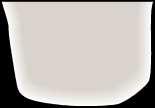
© Pearson Education Limited 2017.All rights reserved.This material is protected under all copyright laws as they currently exist No portion of this material may be reproduced, in any form or by any means, without permission in writing from the publisher 55 y F 30 500 N u x
sin u 600
0.6
36.87°
36.9° Ans.
= sin 30° 500 ; sin u =
u =
=
F
sin
FR
919.61 N = 920 N Ans. Ans: u = 36 9 u = 920 N
R
113.13° 500 = sin 30° ;
=
*2–32.
Resolve each force acting on the gusset plate into its x and y components, and express each force as a Cartesian vector

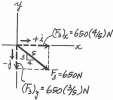

SOLUTION
F1 = {900( + i)} = {900i} N
F2 = {750 cos 45°( + i) + 750 sin 45°( + j)}N
= {530i + 530j} N
Ans. Ans. 4 3
F3 = e 650a 5 b ( + i) + 650 a 5 b ( - j) f N
= {520 i - 390j)}N Ans.

© Pearson Education Limited 2017.All rights reserved.This material is protected under all copyright laws as they currently exist No portion of this material may be reproduced, in any form or by any means, without permission in writing from the publisher 56
y F3 650 N 3 5 F2 750 N 4 45 x F1 900 N
Ans: F1 = 5900i6 N F2 = 5530i + 530j6 N F3 = 5520i - 390j6 N
Determine the magnitude of the resultant force acting on the plate and its direction, measured counterclockwisefrom the positive

SOLUTION
Rectangular Components: By referring to Fig. a, the x and y components of F1, F2, and F3 can be written as
Resultant Force: Summing the force components algebraically along the x y axes, we have
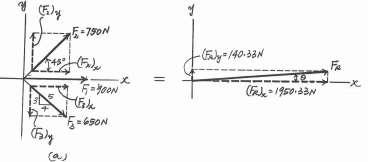
© Pearson Education Limited 2017.All rights reserved.This material is protected under all copyright laws as they currently exist No portion of this material may be reproduced, in any form or by any means, without permission in writing from the publisher 57 2 2 b = 2
33.
–
x
y F3 650 N 3 5 F2 750 N 4 45 x F1 900 N
axis
(F1)x = 900 N (F2)x = 750 cos 45° = 530.33 N 4 (F3)x = 650a 5 b = 520 N (F1)y = 0 (F2)y = 750 sin 45° = 530.33 N 3 (F3)y = 650a 5 b = 390 N
and : + ©(FR)x = ©Fx; + c ©(FR)y = ©Fy; (FR)x = 900 + 530.33 + 520 = 1950.33 N : (FR)y = 530.33 - 390 = 140.33 N c The magnitude of the resultant force FR is FR = 2(FR)x + (FR)y = 21950.332 + 140.332 = 1955 N = 1.96 kN Ans.
direction angle u of FR, measured clockwise
is (FR)y u = tan -1 c(FR)x d = tan -1a 140.33 1950.33 4.12° Ans. Ans:
The
from the positive x axis,
© Pearson Education Limited 2017.All rights reserved.This material is protected under all copyright laws as they currently exist No portion of this material may be reproduced, in any form or by any means, without permission in writing from the publisher 58 FR = 1.96 kN u = 4.12




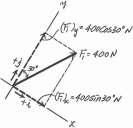
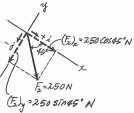
© Pearson Education Limited 2017.All rights reserved.This material is protected under all copyright laws as they currently exist No portion of this material may be reproduced, in any form or by any means, without permission in writing from the publisher 59 2–34. Resolve F1 and F2 into their x and y components. y 60 30 F1 400 N 45 x SOLUTION F1 = {400 sin 30°( + i) + 400 cos 30°( + j)}N = {200i + 346j} N F2 = {250 cos 45°( + i) + 250 sin 45°( - j)}N = {177i - 177j} N Ans. Ans. F2 250 N Ans: F1 = 5200i + 346j6 N F2 = 5177i - 177j6 N
–35.
Determine the magnitude of the resultant force and its

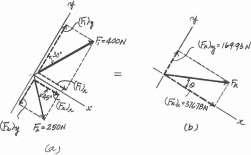
direction measured counterclockwisefrom the positive x axis
SOLUTION
Rectangular Components: By referring to Fig a, the x and y components of F1 and F2 can be written as
Resultant Force: Summing the force components algebraically along the x and y axes, we have

, measured counterclockwise from the positive axis,


© Pearson Education Limited 2017.All rights reserved.This material is protected under all copyright laws as they currently exist No portion of this material may be reproduced, in any form or by any means, without permission in writing from the publisher 60 2
(F1)x = 400 sin 30° = 200 N (F1)y = 400 cos 30° = 346.41 N y 60 30 F1 400 N 45 x F2 250 N (F2)x = 250 cos 45° = 176.78 N (F2)y = 250 sin 45° = 176.78 N
: + ©(FR)x = ©Fx; (FR)x = 200 + 176.78 = 376.78 N Ans. + c ©(FR)y = ©Fy; (FR)y = 346.41 - 176.78 = 169.63 N c The magnitude of the resultant force FR is FR = 2(FR)x + (FR)y = 2376.78 + 169.63 = 413 N Ans. 2 2 2 2
direction angle
of FR, Fig b
is u = tan -1 c (FR)y d = tan -1a 169.63 b = 24.2° Ans. (FR)x 376.78 Ans: FR = 413 N u = 24.2
The
u
Determine the magnitude of the resultant force and its direction, measured counterclockwise from the positive x axis.

© Pearson Education Limited 2017.All rights reserved.This material is protected under all copyright laws as they currently exist No portion of this material may be reproduced, in any form or by any means, without permission in writing from the publisher 61 ¢ ≤ *2–36.
SOLUTION + R FRx = ©Fx; FRx = - 150 cos 30° + 200 sin 45° = 11.518 N Q+ FRy = ©Fy; FRy = 150 sin 30° + 200 cos 45° = 216.421 N FR = 2 (11.518)2 + (216.421)2 = 217 N u = tan - 1 216.421 = 87.0° 11.518 Ans. Ans y 45 F1 200 N x 30 F2 150 N Ans: FR = 217 N u = 87.0
Determine the magnitude of the resultant force and its direction, measured clockwise from the positive x axis.
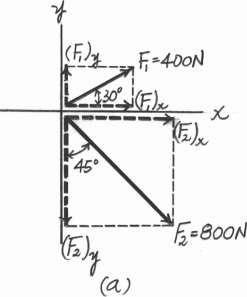
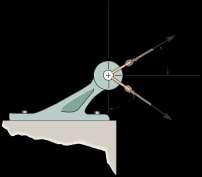
Solution
Scalar Notation. Summing the force components along x and y axes by referring to Fig
Referring
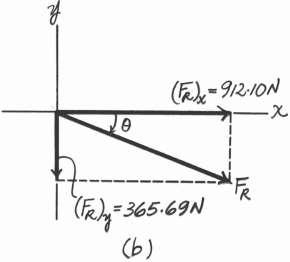
© Pearson Education Limited 2017.All rights reserved.This material is protected under all copyright laws as they currently exist No portion of this material may be reproduced, in any form or by any means, without permission in writing from the publisher 62 a 912.10 2–37.
y 400 N B 30 x 45 800 N
a, S + (FR)x = Fx; (FR)x = 400 cos
+
45 = 912.10 N S + c(FR)y = Fy; (FR)y = 400
= -365.69 N = 365.69 NT
30
800 sin
sin 30 - 800 cos 45
2 2 2 2 FR = 2(FR)x + (FR)y = 2912.10 + 365.69 = 982.67 N = 983 N Ans.
to Fig b, the magnitude of the resultant force is
u
x
is u = tan-1c (FR)y (FR)x 365.69 d = tan-1 b = 21.84 = 21.8 Ans. Ans: FR = 983 N u = 21.8
And its directional angle
measured clockwise from the positive
axis
2-38.
Determine the magnitude of the resultant force and its direction, measured clockwise from the positive x axis.
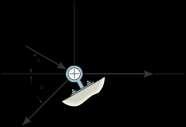
© Pearson Education Limited 2017.All rights reserved.This material is protected under all copyright laws as they currently exist No portion of this material may be reproduced, in any form or by any means, without permission in writing from the publisher 63
y 50 N 30 x 45 70 N Solution Given: 65 N F1 70 N F2 50 N F3 65 N 30 45 FRx = Fx; FRX F1 F2 cos F3 cos FRy = Fy; FRY F2 sin F3 sin FR FRX 2 FRY 2 atan FRY FRX FR 97.8 N 46.5 Ans Ans. Ans: FR = 97.8 N u = 46.5
Express F1, F2, and F3 as Cartesian vectors. y
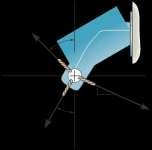
F1 = 5(850) i5(850) j
= {680 i - 510 j} N
F2 = - 625 sin 30° i - 625 cos 30° j
= { - 312 i - 541 j} N
F3 = - 750 sin 45° i + 750 cos 45° j { -530 i + 530 j} N
© Pearson Education Limited 2017.All rights reserved.This material is protected under all copyright laws as they currently exist No portion of this material may be reproduced, in any form or by any means, without permission in writing from the publisher 64 2–39.
F3 750 N 45 SOLUTION 4 3 30 F2 625 N x 5 3 4 F1 850 N
Ans Ans. Ans: F1 = {680i - 510j} N F2 = { - 312i - 541j} N F3 = { - 530i + 530j} N
Ans.
Determine the magnitude of the resultant force and its direction measured counterclockwisefrom the positive x axis
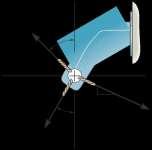

© Pearson Education Limited 2017.All rights reserved.This material is protected under all copyright laws as they currently exist No portion of this material may be reproduced, in any form or by any means, without permission in writing from the publisher 65 f = tan -1 a *2–40.
F3 750 N y 45 SOLUTION : + FRx = ©Fx ; FRx = 4 5(850) - 625 sin 30° - 750 sin 45° = - 162.83 N 3 30 F2 625 N x 5 3 4 F1 850 N + c FRy = ©Fy ; FRy = - (850) - 625 cos 30° + 750 cos 45° = - 520.94 N 5 FR = 2( - 162.83)2 + (- 520.94)2 = 546 N 520.94 162.83 b = 72.64° u = 180° + 72.64° = 253° Ans. Ans. Ans: FR = 546 N u = 253
Determine the magnitude and direction u of the resultant force FR. Express the result in terms of the magnitudes of the components F1 and F2 and the angle f

© Pearson Education Limited 2017.All rights reserved.This material is protected under all copyright laws as they currently exist No portion of this material may be reproduced, in any form or by any means, without permission in writing from the publisher 66 a F 2–41.
SOLUTION F2 2 2 F1 FR R = F1 + F2 - 2F1F2 cos (180° - f) Since cos (180° - f) = - cos f, FR = 2F2 + F2 + 2F F cos f f u Ans. 1 2 1 2 F2 From the figure, tan u = 2 F1 sin f + F1 cos f –1 F1 sin f u = tan ¢ ≤ F2 + F1 cos f Ans. Ans: 2 2 FR = 2F1 + F2 + 2F1F2 cos f F1 sin f u = tan-1 b F2 + F1 cos f
























































































































